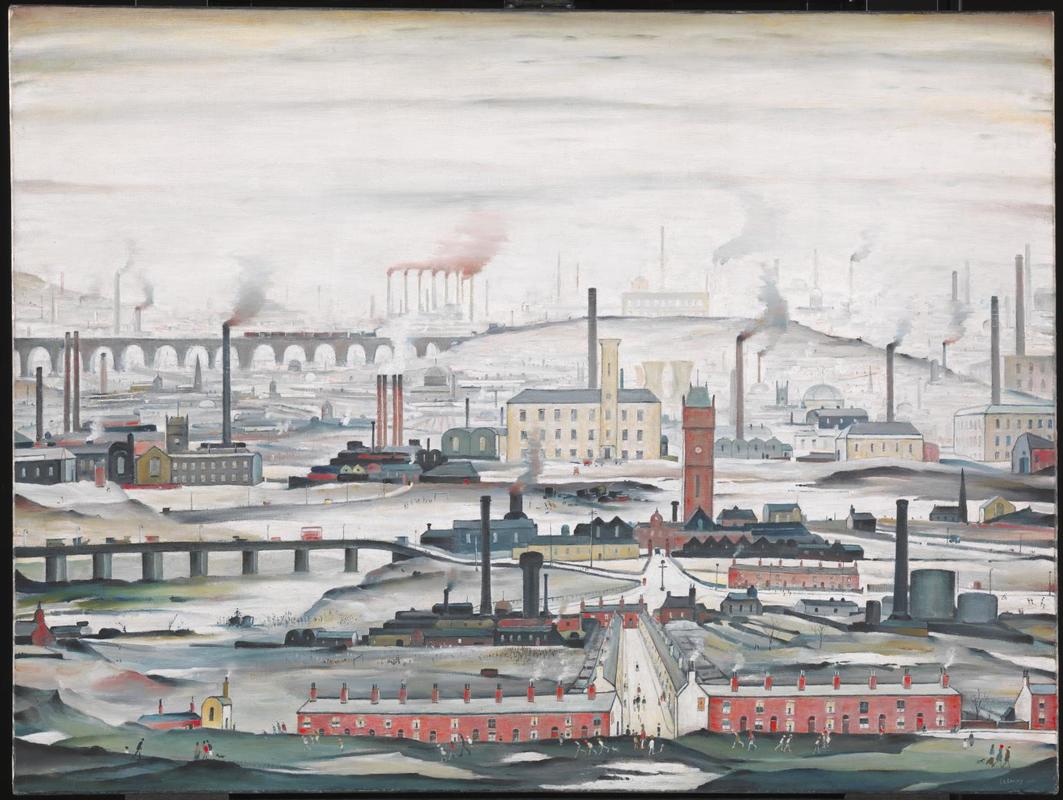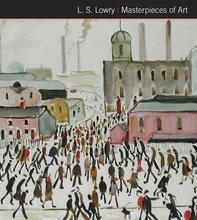More about Industrial Landscape
- All
- Info
- Shop

Contributor
In a story with the cheeky headline, "LS Lowry: The Original Grime Artist," critic Jonathan Jones suggests that the Tate pair Lowry's Industrial Landscape with one of Giorgio de Chirico's "eerie paintings of dreamlike piazzas."
De Chirico's works are the cleaned-up, socially empty cousins of Lowry's, and the unpolished-ness of Lowry, like that of Charles Dickens, or grime and dub music, is a kind of his signature. Dickens innovated by making the metaphorically "little," humble, and poor people of the urban landscape the center of attention, and Lowry's focus on industrial workers did the same. A blogger who saw this painting in the Hong Kong Museum of Art, which owns it and is lending it to the Tate, says that Lowry was untrained, and many other people have the same notion, and, although it is not true, it seems like it could be when you look at the rudimentary, childlike appearance of his "matchstick" figures. You want to say, "This guy is just going off the cuff. He's completely self-taught. He's not part of your art establishment, maaan…," even after you learn, as Lowry reminded interviewers, that he studied for five years with the French painter Adolphe Valette, and then at the Salford School of art for several more years.
Kori Song writes, "Once, after missing a train at the railway station, he noticed the scene of the industrial sector, 'a huge black frame with rows of yellow windows above it...saddled under the sad, wet, afternoon sky' and thus he came to depict such scenes." True or not, what's fascinating is the idea that this unusual man was able to transform the inconvenient, everyday experience of almost all train travelers into enormously popular (though critically neglected) artworks.
Industrial Landscape, like The Pond, is the artist's fictionalized memory of Pendlebury, England, where he lived for decades. "I am not a recorder," Lowry once stated, I've never intended to interpret the industrial landscape as purely the industrial landscape. I'm recording my impression of the industrial landscape. I've always said that." By telling us to take his Industrial Landscape with a big piece of Himalayan pink salt, Lowry is opening up one of the most wonderfully potent, and potentially frightening, paradoxes, famously invoked by the ancient Greeks and revived by the novelist Ursula K. LeGuin, when she wrote, "I am an artist…and therefore a liar. Distrust everything I say. I am telling the truth." Le Guin and Lowry are both saying something similar: sure, art has a sacred capacity, but don't expect it to describe reality or predict the future. Even if sometimes, or even more than sometimes, it does.
Sources
- Bird, Geoff. "Taking a fresh look at LS Lowry." BBC, Jun. 24, 2013, https://www.bbc.com/news/entertainment-arts-22987458.
- Jones, Jonathan. "LS Lowry: The Original Grime Artist." The Guardian, Apr. 18, 2011, https://www.theguardian.com/artanddesign/2011/apr/18/ls-lowry-tate.
- LeGuin, Ursula K.The Left Hand of Darkness. New York: Penguin, 2016.
- Song, Kori. "Laurence Stephen Lowry." Medium, Jan. 21, 2017, https://medium.com/@kori.song/laurence-stephen-lowry-65a39166e270.
Featured Content
Here is what Wikipedia says about Industrial Landscape
Industrial Landscape is the title given to each of a series of oil paintings by the English artist L. S. Lowry, painted over a number of years between 1934 and 1955.
Each picture is in the form of a landscape painting, in which the traditional elements of natural beauty have been supplanted with factories, chimneys, bridges and other elements of an industrial city environment.
One of the most noted Industrial Landscape pieces is a 1955 painting in the Tate Gallery in London; other paintings of the same title are held in the collections of several galleries around the United Kingdom, such as The Lowry in Salford, while others are in private collections.
Check out the full Wikipedia article about Industrial Landscape













